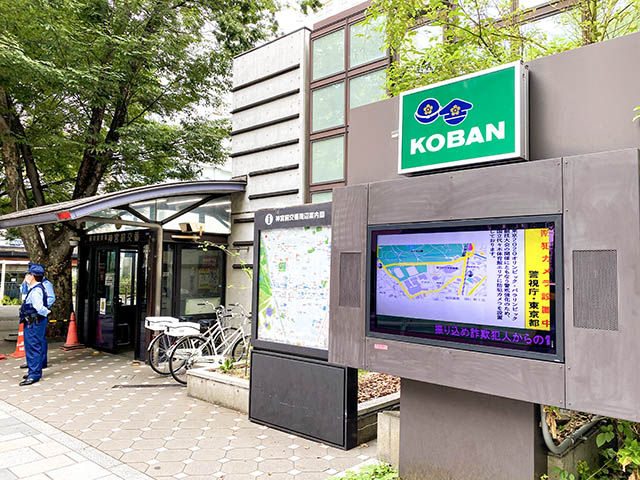
From busy street corners to remote rural train stations, police boxes or Koban can be found all around Japan. These small outposts serve as local policing centers maintaining the safety of the local community. Unraveling its history as well as its structure, you’ll see that there is more to Koban with just an officer standing all day gazing out with a wooden stick.
-
Originating in Japan, “Koban” have been internationally recognized as an effective policing system that is deep-rooted in the local communities. Back in 1874, the first Koban or otherwise known as the policeboxes began in Tokyo Metropolitan Police Department as small shelters for Tokyo’s fledgling police service where police officers took turns to be on guard duty. These are often located near train stations, on main shopping streets, as well as close to important government buildings. Evolving from just a small box shaped, nowadays, some are known for their quirky styles of architecture like the owl police box at Chiba Station.
![Owl police box (Koban) at Chiba Station by day and night]()
Owl police box (Koban) at Chiba Station by day and night
Beyond the contribution to public safety with strict surveillance over individuals, officers’ extensive knowledge of the geography of their jurisdiction to be able to provide clear and accurate directions to those unable to find their desired address have been a salvation to those who need help. The idea, to quote the English website of the Tokyo Metropolitan Police (Keishicho) is that these small outposts “serve the needs of the local community and make the residents feel safe and secure”.
Countries like Brazil introduced the Koban system in some states back in 2000 through the Japanese International Cooperation Agency (JICA) and are reported that the system reduced murder rates considerably in cities such as Sao Paolo. Similarly, Singapore set up their own Koban known as NPP (Neighborhood Police Center)in 1983, and so did the police forces from the United States also adopted the system too.![]()
The term Koban is marked in romanized Japanese to distinguish them from words that would otherwise be homonyms. In addition, after being introduced as the term “Koban” by Profesor D.H Bailey in the ’90s, that term has been appearing in many English documents as is, which led to it being a lingua franca for the term “police box”. It may not be common to encounter if you are in the city but, there are differnet types of Koban; the "Hashutsusho" (police box) and the "Chuzaisho" (residential police box).
![]()
The Hashutsusho (派出所)is a police box typically placed in an urban district and is operated by a number of community police officers who work 24 hours a day under a shift schedule. They conduct activities such as patrolling their communities on foot, by bicycle, or in a patrol car. While on these patrols, officers often conduct door-to-door visits called junkai-renraku(巡回連絡) which are routine visits to homes and workplaces. During these visits, officers listen to residents’ concerns, take down contact information that can be used in the case of natural disasters and other emergency situations, give advice regarding crime and accident prevention, and take suggestions from their community members.
So what is the difference between Hashutsusho and Koban? The answer is very simple. Koban and Hashutshusho are the same. However, to be exact, before 1994, police boxes were called Hashutshusho. And when the Police Act was amended after 1994, the name changed to Koban.
On the other, Chuzaisho (駐在所) which is a residential type police box has a living quarters for officers and their families. These are more common in the suburban and the rural areas. Compared to Hashutsusho, there are only 1 or 2 officers stationed usually with their families. They would act as a small police station for those communities and conduct police duties to maintain safety.![Octopus Shaped Chuzaisho (駐在所) on Himaka Island]()
Octopus Shaped Chuzaisho (駐在所) on Himaka Island
Whether being the Koban or Chuzaisho, these subordinate units of police stations are the focal points of community police activities and play a leading role in maintenance of the safety of local communities. The officers assigned to Koban belong to the Community Police Affairs Division of police station (Keisatu-sho).
Back in 2016, for the first time ever, the police station of Kyoto posted English speaking officers 24/7 at Higashiyama-sho Gion Koban. This "multilingual" trend to be able to assist foreign visitors, was followed by the the local police force of Tokyo, the Metropolitan Police Department posting English and Chinese speaking officers at Shibuya Ekimae Koban in front of Shibuya station and in Kabukicho Koban in Shinjuku's nightlife areas. While Tokyo’s local police force is the Metropolitan Police Department (MPD), other prefectures have their own prefectural police. The MPD and prefectural police have identical functions and authorities within their jurisdictions.
These prefectural police are under the National Police Agency which are responsible for all police forces in Japan. There are seven regional police bureaus, each responsible for a number of prefectures. Metropolitan Tokyo and the island of Hokkaido are excluded from these regional jurisdictions and are run more autonomously than other local forces, in the case of Tokyo, because of its special urban situation, and of Hokkaido, because of its distinctive geography. The National Police Agency maintains police communications divisions in these two areas to handle any coordination needed between national and local forces.![Gion Koban (police box) in Kyoto]()
Gion Koban (police box) in Kyoto






 Go here
Go here





